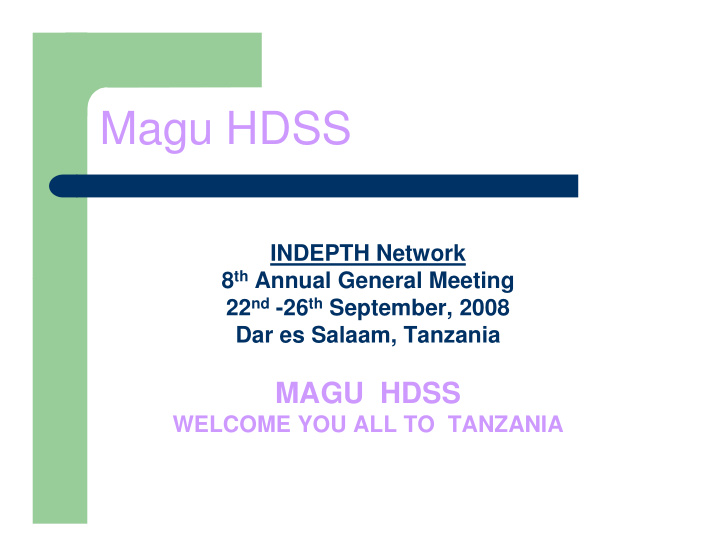



Magu HDSS INDEPTH Network 8 th Annual General Meeting 8 th Annual General Meeting 22 nd -26 th September, 2008 Dar es Salaam, Tanzania MAGU HDSS WELCOME YOU ALL TO TANZANIA
Structure of presentation Introduction to Magu HDSS 1. Methods: Data collection & Data collection and Methods: Data collection & Data collection and 2. 2. Innovations Verbal Autopsy: Data collection and innovations 3. Future of Magu HDSS 4. INDEPTH’s added Value 5.
History � Started in 1994 by the Tanzania Netherlands Support Program on HIV Control (TANESA) Project – Collaborators: � National Institute for Medical Research (NIMR), Mwanza � Regional Medical Office, Mwanza and � Bugando Medical Centre, Mwanza � In December, 2002 Research activities were handed over to NIMR, Mwanza
������������������������������������ �����������������������
Administrative divisions: Six villages
HDSS population Population – Currently about 28,000 – Ethnicity: 95% are Sukuma – Ethnicity: 95% are Sukuma – Religion: 74% Christian, 23% traditional religions, 3% Islam – Education: Fourteen primary schools (11 public & 3 private) and three secondary schools (2 public and 1 private) – Health: Seven health facilities (four public and three private) Economy – Per capita income below $120 per year – Farming is main source of income, petty trading common
Population pyramid, 2007 80+ 75-79 70-74 65-69 60-64 55-59 50-54 45-49 40-44 35-39 30-34 25-29 20-24 15-19 10-14 5-9 0-4 -20 -10 0 10 20 Percent of Population Female Males
���������������������
Objectives of the HDSS & cohort study To measure child and adult mortality and fertility in the general � population and by HIV status To asses the leading causes of death through verbal autopsy � To asses changes in the family structure due to HIV epidemic To asses changes in the family structure due to HIV epidemic � To facilitate understanding of the dynamics of the HIV epidemic � To facilitate assessment the demographic, social and economic � impacts of the HIV/AIDS epidemic To facilitate evaluate the effects of national prevention, treatment and � care interventions as implemented in the HDSS area To provide reliable data for planning at different administrative levels �
Types of research Demographic surveys 1 Serological surveys 2 house to house, whole pop • adults invited to village clinics • keep track of births, deaths • HIV & other lab tests HIV & other lab tests • • and movements and movements every 3 years • 2 or 3 times per year • long questionnaire about • simple, quick questions • behaviour & other risks In depth enquiries 3 Operations research 4 specially selected individuals • community groups, village • sensitive topics • leaders, health services timing as required • help national surveillance • some open-ended questions &/or • timing as required • qualitative interviews IEC activities and feedback •
Timing of the Research Activities Demography Serology ANC surveillance VCT service 0 Jan-94 Jan-95 Jan-96 Jan-97 Jan-98 Jan-99 Jan-00 Jan-01 Jan-02 Jan-03 Jan-04 Jan-05 Jan-06 Jan-07 Jan-08 Jan-0
HDSS : Data collection � Visit every household and collect information from household head or other adult members � Ask about births, pregnancies, deaths, moves in or out � Ask about births, pregnancies, deaths, moves in or out and update information on schooling � Link children to parents and adults to their spouses using line numbers � Follow-up death reports with special verbal autopsy interviews � Completed 21 rounds since 1994 � HDSS Round 22 is currently going on
H DSS data collection form ������������������ ������������������������ ������������������� ������������������� �������������������� ����������������������������� ������������������������� ����������������������� ����������������������� ���������������������������
���������������������������
��������������������������������������
Verbal Autopsy Interviews � Part of the HDSS activities � Started in 1994 after the HDSS baseline census � Started in 1994 after the HDSS baseline census � For deaths in DSS round 1-18 focus was only for death of individuals under 60 years � Starting from round 19,20&21, VA carried out for all deaths � So far VA has been carried out for all deaths listed in DSS round 1-21.
Updating VA Instruments � Prior to doing VA interviews for deaths listed in DSS 19&20 � Looked at existing VA Instruments � Looked at existing VA Instruments (INDEPTH’s, HMN & Our old ones) � Contacted WHO’s Health Matrix Network � Adapted both INDEPTH.s and Health Matrix VA instrument � New tool used for VA for deaths from HDSS round 19,20,21
VA data collection & processing � Interviews conducted by clinicians � Questionnaires: Three types: Neonates 0-4 years, children 5-13 years and adults 14+ years, children 5-13 years and adults 14+ � Interview Clinician assign causes of death in the field � Two independent clinician assign cause of death � When the three assessments agrees the cause is taken as the cause of death � When they disagree it is considered in-determine (unknown)
Prediction of HIV/AIDS associated death � In areas of generalised epidemics verbal autopsy can consistently measure AIDS mortality. It can predict AIDS death up to 88% � Reliable estimate obtained for people 15-44 years � VA tools for estimating AIDS mortality should collect information to single out symptoms like; herpes zoster, oral candidiasis, abscesses/sores or vaginal tumours.
�����������������������
INDEPTH’s added Value Magu HDSS-Member site � Benefits � Capacity building; – � Data management (2006 & 2008) � Data management (2006 & 2008) � VA Coding (Accra 2003) � VA training-Rufiji (April, 2008) � Writing skills (Workshop Accra Aug., 2008) Publications – � Fertility monograph (on going) � Facilitating Developing multi-site proposals (currently – ’cost of illness’) Sharing of data/information with other sites – Scientific advancement through the Scientific conference during – AGMs
Future � Increase frequency of HDSS data collection to three rounds per annum � Start using PDAs (small hand held computers) for data collection � Carry out VA interview soon after the death has been registered
�
Recommend
More recommend